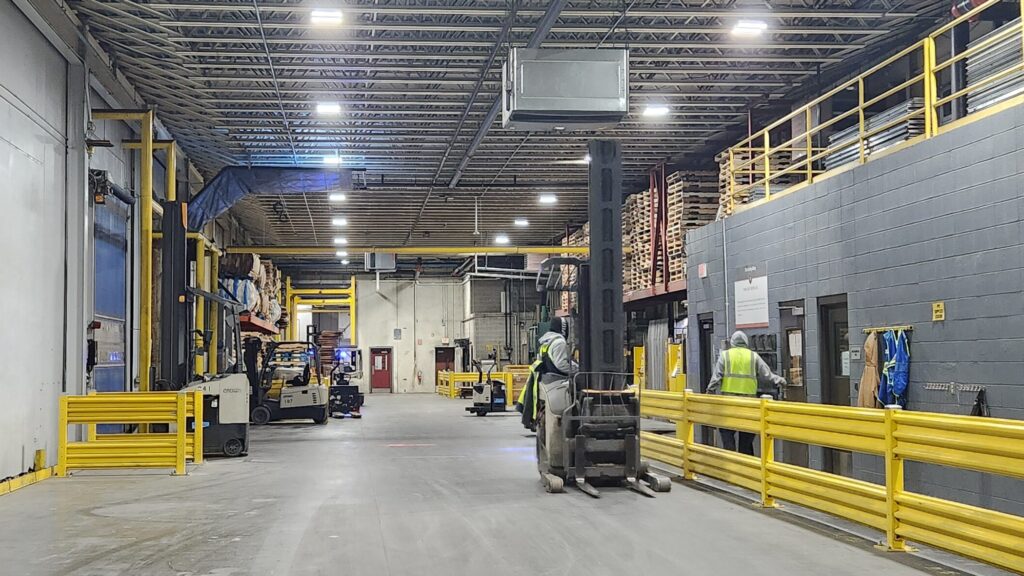When sourcing food-grade warehousing for your business from a 3PL partner, several factors must be considered to ensure that your products are stored safely and efficiently. You want to be certain that the 3PL partner you pick is well-versed in proper food storage and distribution and knowledgeable about the complexities of legislation and regulatory compliance related to storing food-grade products.
Here are 5 questions to ask and look for when sourcing food-grade warehousing.
1. Does the 3PL Warehouse Offer Ambient, Refrigerator, and Freezer Temperature Zones?
One of the most important features of food-grade warehousing is the ability to offer a variety of temperature zones. Depending on the food you’ll be storing, you may need ambient (room temperature), refrigerated, or frozen storage options.
- Ambient: This room temperature zone is used for dry goods, canned foods, grains, and other products that do not require cold storage.
- Refrigerated: Ideal for perishable items such as dairy, fresh produce, meat, seafood, and beverages. This zone is kept between 34°F and 40°F (1°C – 4°C) to preserve product freshness.
- Freezer: For products that need to be kept at temperatures below freezing, such as frozen foods, ice cream, and certain meats, a 3PL warehouse must have a well-maintained freezer zone.
Ensuring that a 3PL warehouse offers these various temperature-controlled zones allows you to store different types of food under optimal conditions, reducing the risk of spoilage and ensuring product quality.
2. Is the 3PL Warehouse Facility Kept in Good Working Order?
A well-maintained 3PL warehouse is essential for safe and efficient food storage. Look for facilities that demonstrate a high standard of maintenance, as even minor issues can impact the quality and safety of food products.
- Regular Maintenance Checks: Ensure the 3PL warehouse has a regular schedule for checking equipment such as refrigeration units, forklifts, and storage racks. Any equipment failures could lead to temperature fluctuations, product loss, or delays.
- Cleanliness: The facility should adhere to strict sanitation protocols to avoid contamination. This is especially important for food products, as poor hygiene could lead to foodborne illnesses or spoilage.
- Pest Control: Ensure the facility has a comprehensive pest control program in place. Pests such as rodents or insects can contaminate food, making it unsafe for consumption.
A 3PL warehouse that stays in good working order not only reduces the likelihood of costly mistakes but also enhances the overall quality of service you receive.
3. Is the 3PL Warehouse Facility FDA-Compliant?
Food storage facilities must meet certain regulatory standards to ensure the safety of the products they store. The U.S. Food and Drug Administration (FDA) sets guidelines for food storage and handling to prevent contamination, spoilage, and other risks to food safety.
- Compliance with Food Safety Regulations: Ensure the 3PL warehouse is compliant with the FDA’s Food Safety Modernization Act (FSMA) and other relevant local and state regulations. This includes meeting requirements for temperature controls, hygiene, pest management, and employee training.
- Certifications: Look for certifications such as ASI Audit – cGMP Certification. This certification means a facility has been audited and is in compliance with current good manufacturing practice regulations and was evaluated on equipment and facility maintenance, documentation, standard operating procedures, personnel, and quality control.
Working with a 3PL warehouse that is FDA-compliant not only helps you meet your regulatory requirements but also ensures that the food products you store are safe and suitable for human consumption.
4. Does the 3PL Warehouse Offer Climate-Controlled Transportation Services?
While storage is a key part of the logistics chain, transportation is just as important—especially when moving temperature-sensitive goods. Many food distribution companies offer not only climate-controlled storage but also climate-controlled transportation to help maintain the integrity of your products as they move in and out of storage.
When selecting a 3PL warehouse, ask if they provide integrated logistics solutions that include:
- Temperature-controlled trucks: Refrigerated and freezer trucks that can keep your goods at the required temperature during transit.
- Real-time monitoring: Some providers offer GPS and temperature monitoring systems that track the temperature and location of shipments in real-time. This ensures that your products are consistently kept within the required temperature range as they are transported.
Having a 3PL warehouse that offers both storage and transportation services reduces the risk of product exposure to fluctuating temperatures during transit, helping you maintain the quality and safety of your food products.
5. How Is Inventory Monitored and Managed in the 3PL Warehouse?
Efficient inventory management is vital in a food-grade warehouse to ensure products are tracked, stored properly, and rotated, as necessary. The method of inventory tracking can affect everything from order accuracy to product expiration.
- Inventory Management Systems: A 3PL warehouse with advanced inventory management systems, such as barcode scanning or RFID technology, can help ensure that all products are easily located and monitored. These systems can also track product expiry dates and facilitate proper stock rotation.
- Real-Time Updates: Look for a 3PL warehouse that provides real-time access to inventory data, allowing you to track your products and make informed decisions regarding stock levels and shipments.
- Stock Rotation: Proper stock rotation is essential in food warehousing. Check that the 3PL warehouse uses FIFO (First In, First Out) or FEFO (First Expired, First Out) methods to ensure older stock or those nearing expiration are used or sold first.
A 3PL warehouse that uses innovative inventory management tools can reduce waste, prevent spoilage, and improve overall operational efficiency.

Takeaway
Choosing the right food-grade warehouse involves more than just securing a storage space for your products. You need a facility that offers the right temperature zones for your products, is well-maintained, FDA-compliant, and provides integrated logistics services. Additionally, a robust inventory management system ensures that your products are stored safely and efficiently while allowing you to track their status in real-time.
By considering these key factors, you can ensure that your food distribution needs are met with the highest safety and quality standards, helping your business run smoothly and ensuring your customers receive fresh, safe products every time.
Are you looking for a 3PL warehouse to store your food-grade products? Click here to learn about Valley’s storage solutions.


